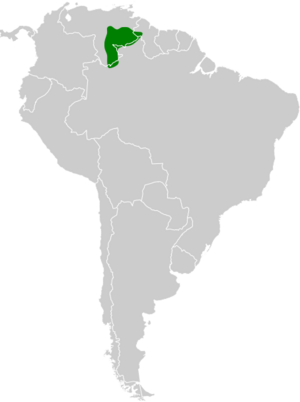Roraiman antwren facts for kids
Quick facts for kids Roraiman antwren |
|
|---|---|
| Conservation status | |
| Scientific classification | |
| Genus: |
Herpsilochmus
|
| Species: |
roraimae
|
 |
|
The Roraiman antwren (Herpsilochmus roraimae) is a small bird that loves to eat insects. It belongs to a bird family often called "typical antbirds." You can find this special bird in parts of Brazil, Guyana, and Venezuela.
Contents
About the Roraiman Antwren
How Scientists Name Them
The Roraiman antwren was first described by a scientist named Carl Hellmayr in 1903. He found it near Mount Roraima in Guyana. Scientists group animals that are alike. This bird is part of a group called Herpsilochmus. It seems to be most closely related to the spot-backed antwren.
Different Kinds of Roraiman Antwrens
There are two slightly different types, or subspecies, of the Roraiman antwren:
- H. r. roraimae
- H. r. kathleenae
What the Roraiman Antwren Looks Like
This bird is about 12 to 13 centimeters (5 inches) long. It has the longest tail of all birds in its group.
Male Roraiman Antwrens
Adult males of the main type have a black cap on their head and neck. They have a long, pale gray or white stripe above their eye, like an eyebrow. A black stripe goes through their eye. Their cheeks are grayish.
Their back and rump (the area above the tail) are dark gray. Many feathers on their back have white edges. They also have blackish patches and white-edged feathers on their shoulders. There's a white patch between their shoulders.
Their wings are black with white tips on some feathers. The main flight feathers have white edges near the end. Their tail is black with white tips on the feathers. The middle tail feathers have white spots, and the outer ones have white edges. Their throat and belly are mostly gray, with a white center on their belly.
Female Roraiman Antwrens
Adult females look a lot like the males. But they have white spots on their cap. The sides of their neck have a light yellowish-brown tint. Their chest and sides are light yellowish-brown, and their tail spots are smaller than the males'.
Differences in Subspecies
Males of the H. r. kathleenae subspecies look like the main type. But females of this subspecies have grayer upper parts. Their chest and sides are pale gray, not light yellowish-brown.
Where the Roraiman Antwren Lives
The Roraiman antwren lives in a special area called the tepui region. This is where southern Venezuela, western Guyana, and northwestern Brazil meet.
Specific Locations
- The main subspecies (H. r. roraimae) is found in Bolívar state in Venezuela, northern Roraima in Brazil, and west-central Guyana.
- The H. r. kathleenae subspecies lives in Bolívar and Amazonas states in Venezuela. It is also found in northern Amazonas state in Brazil.
Its Home Environment
This bird lives in wet evergreen forests. It prefers the middle and top parts of the trees. At lower elevations, it likes taller trees with rich soil. It also lives in shorter, more stunted forests near the tops of tepuis. It can even be found where these stunted forests meet the brushy grasslands above them. You can find them at heights between 700 and 2000 meters (2,300 to 6,600 feet) above sea level.
Roraiman Antwren Behavior
Movement
Scientists believe the Roraiman antwren stays in the same area all year round. It does not migrate.
Feeding Habits
We don't know all the details about what the Roraiman antwren eats. But we know it eats insects and probably spiders. It hunts for food alone, in pairs, or in family groups. Often, it joins a group of different bird species that are all looking for food together.
It usually feeds high up in tall forests, about 30 meters (100 feet) above the ground. But in shorter forests, it can feed as low as 3 meters (10 feet). It mostly looks for food at the ends of leafy branches and in the tops of trees. It moves quickly and carefully. It usually catches its prey by picking insects off leaves, stems, and vines. It might reach out or lunge from its perch. Sometimes, it makes short flights to hover and pick off an insect. It is not known to follow army ants, which some other birds do to catch insects disturbed by the ants.
Reproduction and Life Cycle
Sadly, we don't know anything about how the Roraiman antwren breeds or raises its young.
Vocalizations
The Roraiman antwren's song is very high, loud, and fast. It's a series of about 12 chipping notes. The last 3 or 4 notes go down in pitch and slow down. Its calls include very quick "chup" notes. These can be given alone or repeated fast. It also has a slightly longer, downward-sloping "tewp" call, which can also be repeated quickly.
Conservation Status
The IUCN (International Union for Conservation of Nature) has listed the Roraiman antwren as a species of "Least Concern." This means it is not currently in danger of disappearing.
It lives across a large area. We don't know exactly how many Roraiman antwrens there are, but their numbers are thought to be slowly decreasing. No immediate threats have been found. It is considered fairly common in many parts of its range. Its home includes some large protected areas.
Scientists believe this bird is very sensitive to human activity. However, there is still a huge amount of untouched forest where it lives. So, the current threat from human disturbance is low.


